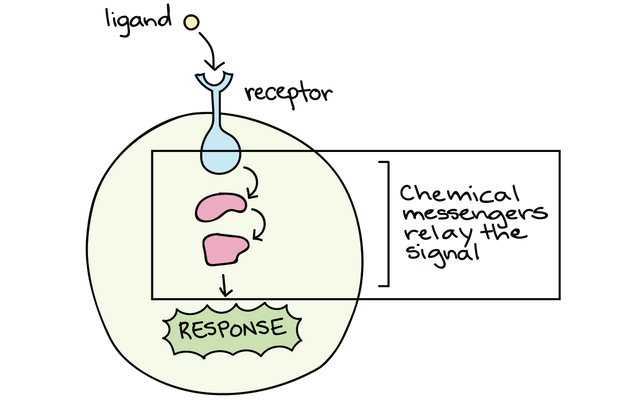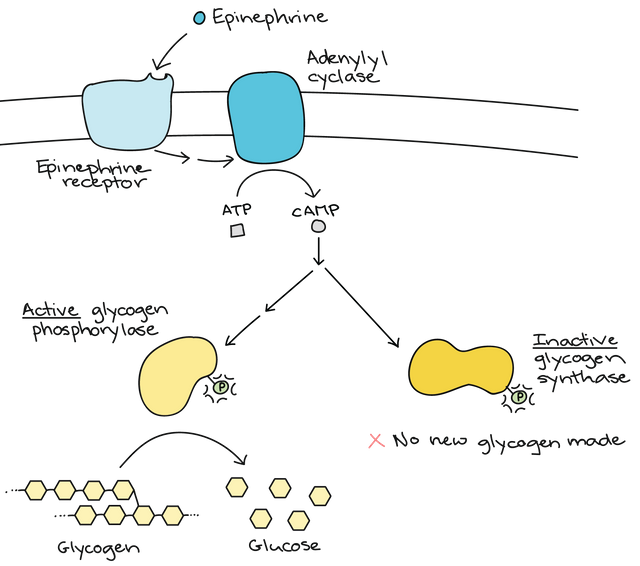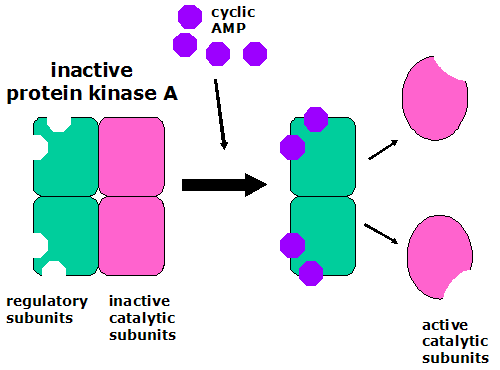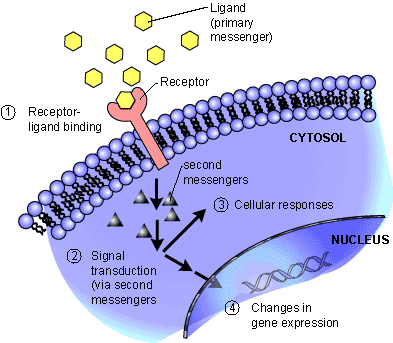How the F@#k Do Cells Respond to Each Other? № 2

Cells respond by mechanisms through which extracellular signals exert control over cell function.
We begin by explaining the basic ideas behind signal transduction pathways, emphasizing how these pathways amplify signals and provide additional levels of control and coordination. Signal transduction often involves the phosphorylation of proteins, which is a common mechanism for turning proteins on or off. A few small molecules that are not proteins as well as ions, also play important roles in cell signaling by acting as second messengers inside the cell. The response of cells to signals may involve turning on or off the activity of existing proteins or may regulate gene expression if the end product of a signal transduction pathway acts as a transcription factor in the nucleus.
The binding of a ligand to a receptor protein changes the shape and, thus, the activity of the receptor.
This is usually only the first step in a cascade of events that converts the original signal into a molecular form that brings about a functional cellular response. Such a cascade is called a signal transduction pathway or a signal transduction cascade. We know that one functional response to epinephrine is to cause liver cells to convert sugars from the complex storage form of glycogen to a simpler form (glucose) that is released into the bloodstream, to provide a quick source of energy. The conversion of glycogen to glucose in the liver depends on the activity of an enzyme called glycogen phosphorylase. Therefore, the binding of epinephrine to a receptor must cause a change in the activity of an enzyme.

Enzyme activity can be regulated in several ways.
Epinephrine could affect an enzyme ultimately by regulating the expression of its gene; if more of the enzyme is synthesized, the overall activity level in the cell will be higher. This type of control does take place. Another method of control, however, would be to activate inactive copies of the enzyme. Although it is expensive for cells to build proteins, it also takes a certain amount of time, which may be far too long for the cell to wait (certainly too long for the fight-or-flight response). In cases where a faster response is adaptive, cellular mechanisms have evolved to activate existing proteins.
One important method involves phosphorylation (the addition of a phosphate group).
- Phosphate groups are highly negatively charged, and their addtion generally has a profound effect on a protein’s shape. In particular, proteins will typically occur in an inactive form without a phosphate group and in an active form with one.
- The function of many types of enzymes is simply to phosphorylate other enzymes; the general name for such an enzyme is a protein kinase. Protein kinases are so important that 1 of every 100 eukaryotic genes may code for one.
- The sequential phosphorylation of a series of protein kinases is an important, common mechanism in signal transduction cascades.
- In the case of epinephrine, cAMP triggers a series of proteins to sequentially phosphorylate each other, from protein kinase A to phosphorylase kinase to glycogen phosphorylase, with the last being the enzyme that converts glycogen to glucose.

Signal transduction pathways have several advantages over a more direct mode of activation.
First, the signal becomes amplified by the cascade, because each step progressively activates a larger number of molecules. In this way, a very small number of signal molecules can quickly lead to the activation of a very large number of functional molecules. One calculation suggests that a single molecule of epinephrine will cause 100 million molecules of glycogen phosphorylase to be activated.
Another important consequence of a signal cascade is that the activation of different proteins in the cascade can produce multiple functional outcomes. For example, one of the phosphorylation steps in epinephrine response deactivates glycogen synthase, which normally synthesizes glycogen. Thus, not only will epinephrine enable the break down of glycogen into glucose, but it will also disable the creation of new glycogen.
Signal cascades also allow cross talk among different pathways; instead of acting in a linear fashion, most cascades are networks with multiple inputs and outputs. In epinephrine response, the initial blood glucose level may be very high and the production of more glucose may actually be disadvantageous. Other signaling cascades can modulate glucose production to avoid damage. In general, the interaction of kinases with other signal molecules creates a much higher level of control and feedback than would otherwise be possible.

Special sets of small nonprotein molecules also play key roles in signal transduction pathways.
cAMP, for example, is produced by adenylyl cyclase and activates the first protein kinase in the epinephrine signal transduction pathway. In this position, cAMP is the first intracellular signal resulting from the extracellular signal of epinephrine. cAMP and other molecules of its type are referred to as second messengers because they are the next in line after the original external signal (i.e., the first messenger). IP3, DAG, and calcium ions also serve as second messengers in cells. Calcium ions are notable both because they are so simple and because they bind to a protein called calmodulin to carry out their second messenger function.
The response of cells to signals involves either turning on or turning off the activity of proteins already present in the cell, or turning on or off the synthesis of new proteins through the control of gene expression.
The rapid production of glucose in the liver is an example involving an enzyme that exists in an inactive form in the cell, which is rapidly activated by the signal transduction pathway stimulated by the epinephrine signal. The epinephrine kinase pathway, however, also activates in the nucleus a transcription factor that controls the expression of the glycogen phosphorylase gene. Once activated, this transcription factor contributes to longer-lasting response by facilitating the synthesis of more enzyme molecules.

Signals affect the activity of only certain cells; further, different kinds of cells responding to the same signal can have completely different responses.
Whether or not a cell responds to a signal depends entirely on whether it expresses the protein that serves as the receptor for that signal. The same receptor found in different types of cells may activate different kinds of signal transduction pathways with different functional endpoints. The diversity of proteins found in different kinds of cells explains the diversity of cell responses to signals; at the same time, the fact that different cells may share some common types of proteins accounts for diverse responses to a common signal, such as epinephrine.
Sources:
Image Credits:
https://ka-perseus-images.s3.amazonaws.com/675fd80883edf0625857e7e80a6914d4521ac53f.png
http://www.nature.com/scitable/content/ne0000/ne0000/ne0000/ne0000/14705982/U1CP5-1_InhibitionActivati_ksm.jpg
https://ka-perseus-images.s3.amazonaws.com/29d97104e7565901e86c0a4f300ab5856db69c93.png
http://courses.washington.edu/conj/gprotein/kinasea.gif
https://qph.ec.quoracdn.net/main-qimg-7d79b81f0a1c510da46f15668aa63ae0?convert_to_webp=true
Bird [Giphy](https://giphy.com/gifs/blue-5lDik5jPpRw2Y)

BTC: 1JQWNxziArfaCtxsP3tUQ4VSTBY9jresmt 


